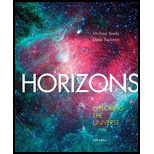
Horizons: Exploring the Universe (MindTap Course List)
14th Edition
ISBN: 9781305960961
Author: Michael A. Seeds, Dana Backman
Publisher: Cengage Learning
expand_more
expand_more
format_list_bulleted
Concept explainers
Question
Chapter 9, Problem 5P
To determine
The diameter of the bubble in arc seconds.
Expert Solution & Answer
Trending nowThis is a popular solution!

Students have asked these similar questions
Suppose two protostars form at the same time, one with a mass of 0.5MSunSun
[Select ALL answers that are true in alphabetical order]A) The 10MSun protostar will have a smaller change in surface temperature during this phase than the 0.5MSun protostar.B) The 10MSun protostar will reach the main sequence cooler and fainter than the 0.5MSun protostar.C) The 10MSun star will end its main-sequence life before the 0.5MSun star even completes its protostar stage.D) The 10MSun protostar will have a smaller change in luminosity during the sequence shown than the 0.5MSun protostar.E) The 10MSun protostar will be much more luminous than the 0.5MSun protostar.
For each problem, use the following values:
c = 3x108 m/s
mass of the sun = 1.989 x 1030 kg
luminosity of the sun = 3.828 x 1026 W
1 AU = 1.496 x 1011 m
1 pc = 3.262 light years = 3.086 x 1016 m
1 year=3.154x107 seconds
Critical density of our Universe (expressed as a mass density): Pcrit =8.7 x 10-27 kg m-³
Critical energy density of our Universe: Ecrit = Pcrit c²
G=6.674 × 10-11 m³.kg-1.s-2
1 eV = 1.60218 x10-19.
Boltzmann constant: kg = 1.381 x 10-23 JK-18.617 × 10-5eV K-1
energy density constant (in Stefan Boltzmann Law): a = 7.566 x 10-16 Jm-3 K-4 -4.7 x 10-³ MeV m-3 K-4
Constant in Wein displacement law: b = 2.898 x 10-3 m K
baryon-to-photon ratio, n = 6 x 10-10
White Dwarf Size II. The white dwarf, Sirius B, contains 0.98 solar mass, and its density is about 2 x 106 g/cm?. Find the radius of the white dwarf in km to three significant digits. (Hint: Density = mass/volume, and the volume of a
4
sphere is Tr.)
3
km
Compare your answer with the radii of the planets listed in the Table A-10. Which planet is this white dwarf is closely equal to in size?
I Table A-10 I Properties of the Planets
ORBITAL PROPERTIES
Semimajor Axis (a)
Orbital Period (P)
Average Orbital
Velocity (km/s)
Orbital
Inclination
Planet
(AU)
(106 km)
(v)
(days)
Eccentricity
to Ecliptic
Mercury
0.387
57.9
0.241
88.0
47.9
0.206
7.0°
Venus
0.723
108
0.615
224.7
35.0
0.007
3.4°
Earth
1.00
150
1.00
365.3
29.8
0.017
Mars
1.52
228
1.88
687.0
24.1
0.093
1.8°
Jupiter
5.20
779
11.9
4332
13.1
0.049
1.30
Saturn
9.58
1433
29.5
10,759
9.7
0.056
2.5°
30,799
60,190
Uranus
19.23
2877
84.3
6.8
0.044
0.8°
Neptune
* By definition.
30.10
4503
164.8
5.4
0.011
1.8°
PHYSICAL PROPERTIES (Earth = e)…
Chapter 9 Solutions
Horizons: Exploring the Universe (MindTap Course List)
Ch. 9 - Prob. 1RQCh. 9 - Why evidence can you cite that the interstellar...Ch. 9 - Prob. 3RQCh. 9 - Prob. 4RQCh. 9 - Prob. 5RQCh. 9 - Prob. 6RQCh. 9 - Prob. 7RQCh. 9 - Prob. 8RQCh. 9 - Prob. 9RQCh. 9 - Prob. 10RQ
Ch. 9 - Prob. 11RQCh. 9 - Prob. 12RQCh. 9 - How does the CNO cycle differ from the...Ch. 9 - Prob. 14RQCh. 9 - Step-by-step, explain how energy flows from the...Ch. 9 - Prob. 16RQCh. 9 - Prob. 17RQCh. 9 - Prob. 18RQCh. 9 - Prob. 19RQCh. 9 - Prob. 20RQCh. 9 - Prob. 1DQCh. 9 - What is your favorite home-cooked meal? In terms...Ch. 9 - Prob. 3DQCh. 9 - How does hydrostatic equilibrium relate to hot-air...Ch. 9 - Prob. 1PCh. 9 - Prob. 2PCh. 9 - Prob. 3PCh. 9 - Prob. 4PCh. 9 - Prob. 5PCh. 9 - Prob. 6PCh. 9 - Prob. 7PCh. 9 - Prob. 8PCh. 9 - Prob. 9PCh. 9 - Prob. 10PCh. 9 - If a protostellar disk is 200 AU in radius and the...Ch. 9 - Prob. 12PCh. 9 - Prob. 13PCh. 9 - Prob. 14PCh. 9 - H much energy is produced when the CNO cycle...Ch. 9 - Prob. 16PCh. 9 - Prob. 1LTLCh. 9 - Prob. 2LTL
Knowledge Booster
Learn more about
Need a deep-dive on the concept behind this application? Look no further. Learn more about this topic, physics and related others by exploring similar questions and additional content below.Similar questions
- Calculate the angular diameter of a prestellar nebula of radius 125 AU lying 150 pc from Earth. angular diameter = 15. ΑΣΦ B ? arc secondsarrow_forwardIf a protostellar disk is 200 AU in radius and the disk plus the forming star together contain 2 solar masses, what is the orbital speed at the outer edge of the disk in kilometers per second? (Hint: See the formula for circular orbital velocity in Reasoning with Numbers 4-1.)arrow_forward
Recommended textbooks for you
 Foundations of Astronomy (MindTap Course List)PhysicsISBN:9781337399920Author:Michael A. Seeds, Dana BackmanPublisher:Cengage Learning
Foundations of Astronomy (MindTap Course List)PhysicsISBN:9781337399920Author:Michael A. Seeds, Dana BackmanPublisher:Cengage Learning Stars and Galaxies (MindTap Course List)PhysicsISBN:9781337399944Author:Michael A. SeedsPublisher:Cengage Learning
Stars and Galaxies (MindTap Course List)PhysicsISBN:9781337399944Author:Michael A. SeedsPublisher:Cengage Learning
 Horizons: Exploring the Universe (MindTap Course ...PhysicsISBN:9781305960961Author:Michael A. Seeds, Dana BackmanPublisher:Cengage Learning
Horizons: Exploring the Universe (MindTap Course ...PhysicsISBN:9781305960961Author:Michael A. Seeds, Dana BackmanPublisher:Cengage Learning

Foundations of Astronomy (MindTap Course List)
Physics
ISBN:9781337399920
Author:Michael A. Seeds, Dana Backman
Publisher:Cengage Learning

Stars and Galaxies (MindTap Course List)
Physics
ISBN:9781337399944
Author:Michael A. Seeds
Publisher:Cengage Learning


Horizons: Exploring the Universe (MindTap Course ...
Physics
ISBN:9781305960961
Author:Michael A. Seeds, Dana Backman
Publisher:Cengage Learning